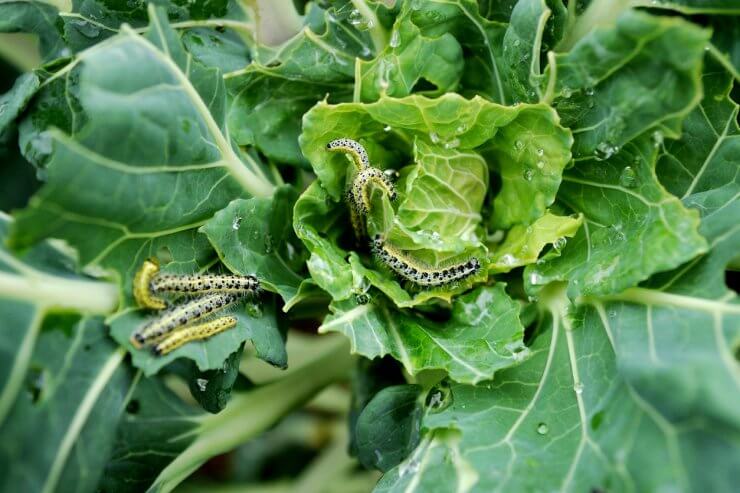
Caterpillars on a Brussels Sprout plant
It’s essential that you check your plants for pests on a regular basis to squash any problems at the outset. Daily inspections will help keep your plants pest-free, and in many cases you can get the problem under control with your garden hose!
Spot the symptoms of Brussels sprout plant pests
Check leaves, stems, and sprouts for these symptoms:
| Symptom | Pest |
| Plants wilt and shrivel. When you pull up the plants, you can see rice-size white maggots feeding on the roots. | Cabbage root maggot |
| Holes in plant leaves; destroyed seedlings | Slugs, snails |
| Black deposits of “honeydew” | Cabbage aphids |
| Holes in leaves or sprouts | Cabbage loopers |
| Holes in plant leaves | Diamondback moth/Cabbage moth |
| Seedlings cut off at soil level | Cutworms |
How to treat pests on Brussels sprout plants
Here are some proven ways to get rid of pests on your Brussels sprout plants. Choose the best treatment for the type of pests invading your plants.
- Pick off the pests. Use your garden gloves to remove the pests by hand. After removal, destroy pests by drowning them in a bucket of soapy water or crushing them with your foot. Handpicking isn’t efficient or practical for very small pests but works well with larger pests such as cabbage loopers.
- Blast off the pests. Use your garden hose to blast pests off your plants; this is often an effective approach with aphids.
- Set a trap. For hungry pests such as slugs and snails, invite them over for a beer. Pour beer to a depth of about an inch in a plastic container or an aluminum pie plate; set it into the ground next to your at-risk plants so the beer is at soil level. The next day, check the trap. Many of the slugs and snails will likely have ventured into the garden saloon only to find there was no way out. Toss the beer and its contents out, away from your garden, and let the neighborhood birds have a snack.
- Apply insecticidal soap. Insecticidal soap is organic. The potassium salts in insecticidal soap help remove an insect’s protective waxes, causing destruction of insect membranes and killing them. Insecticidal soaps are particularly effective on smaller pests such as aphids, psyllids, and spider mites. Mix the soap with water to create your solution and apply directly to insects on any plants. While insecticidal soap is less apt to affect other organisms, certain plants might be sensitive to the soap and can suffer leaf burn.
- Apply horticultural oils. Combine plant- or petroleum-based oils with water to produce horticultural sprays. Neem oil, for instance, is derived from seed extracts of the neem plant. Oil-based sprays block an insect’s air holes, interfere with an insect’s metabolism, disrupt insect feeding, and inhibit insect growth. Like insecticidal soaps, horticultural oils can cause plant injury if not properly diluted.
- Make your own pest spray. You can make your own pest spray with benign materials. Mix one tablespoon of baking soda, 1/2 teaspoon of a mild dish detergent, and 2 1/2 tablespoons of olive oil in a gallon of water to make a solution that will repel all kinds of bugs, as well as a fungicide for blight and mildew on the Brussels sprout plant leaves. Shake it well in your bottle before spraying and repeat every week for it to be continuously effective.
- Invite pest predators. Other insects, such as ladybugs, love aphids. Plant pollinator-friendly flowers near your garden for some natural pest defense.
Do pests attack your Brussels sprout plants every year? How do you handle removing them—and even preventing them in the first place? Please tell us how you treat your Brussels sprout plants to avoid pests.


 Previous
Previous

